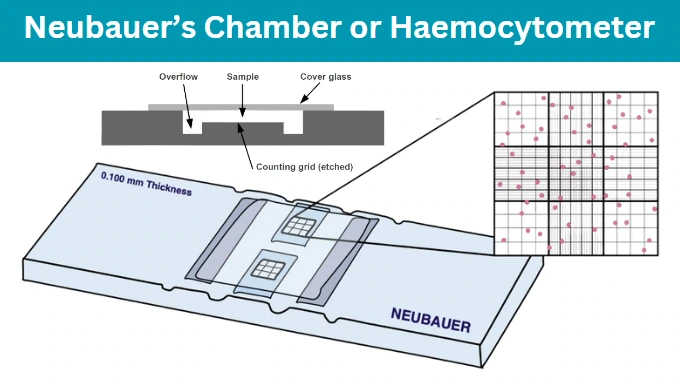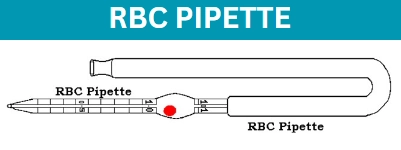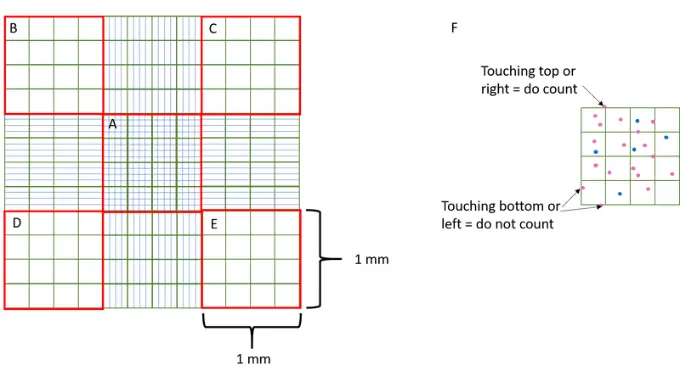Want to accurately diagnose your health? Learn the best RBC count method here! Our expert guide reveals everything you need to know.
Haemocytometry quantitatively measures the number of RBCs in a blood sample using the RBC count method. RBCs are counted manually using a haemocytometer or Neubauer’s chamber slide.
RBC Count Method is a laboratory test used to measure the number of red blood cells (RBCs) in a person’s blood. RBCs are important because they carry oxygen from the lungs to the rest of the body and transport carbon dioxide back to the lungs to be exhaled.
Measuring RBCs is therefore an essential part of diagnosing and monitoring many medical conditions. RBC Count Method is also known as an erythrocyte count.
It is impossible to count the RBCs in a blood sample directly. Because of this, it is essential to dilute the blood sample or blood specimen using one of the RBC diluting fluids, such as hayem’s or formalin citrate.
What are RBCs?
- RBC stands for Red Blood Cell, also known as erythrocyte
- RBCs are responsible for carrying oxygen from the lungs to the rest of the body
- RBCs are the most abundant type of blood cell in the human body, making up about 40-45% of the blood volume in adults
- RBCs have a biconcave disc shape, which allows them to travel through tiny blood vessels and deliver oxygen to tissues
- The production and maintenance of RBCs are regulated by the hormone erythropoietin, which is produced by the kidneys
- The RBC count is essential to a routine blood test and can help detect various conditions.
Purpose and Significance of Total Red Blood Cell (RBC) Count
The purpose of performing a total Red Blood Cell (RBC) count is to measure the number of red blood cells in a given blood volume. This test is typically ordered as part of a complete blood count (CBC). It can be used to help diagnose a variety of medical conditions, such as anaemia, polycythemia, and leukaemia.
A low RBC count can indicate anaemia, a condition where there are not enough red blood cells to transport oxygen throughout the body adequately. An elevated RBC count may indicate polycythemia, a disease with too many red blood cells, leading to the thickening of the blood and an increased risk of blood clots.
RBC Count Method Principle
The principle of RBC counting involves using a laboratory technique to determine the number of red blood cells in a given blood volume. The most common method for RBC counting is the automated haematology analyzer, which uses electrical impedance to measure the number and size of cells in a blood sample.
The blood sample is first diluted (1:200) with RBC dilution fluid (also known as Hayem Fluid) to protect and fix the red blood cells. Hayem fluid is not harmful to red blood cells. Normal saline solutions can also be used, however, this causes red blood cell production and rouleaux development, which can lead to mistakes.
After diluting the specimen, its contents are placed into Neubauer’s chamber. The cells are then counted in areas corresponding to the RBC count.
Labs now use two types of RBC diluting liquid: Hayem’s and Formalin Citrate diluting Fluid.
Material and Requirements of Total RBC Count
The requirements of the RBC count method are as follows:
1. Neubauer’s Chamber or Haemocytometer
Neubauer’s chamber, a hemocytometer, is a scientific instrument used for precise and accurate cell counts. It is often used to measure the concentration of cells in a blood sample, including red blood cells, white blood cells, and platelets.
The hemocytometer comprises a glass slide with a rectangular depression in the centre. Haemocytometer has a size of 30 X 70 X 4 mm. The counting grid has a size of 3 mm X 3 mm.
To use a hemocytometer, a small blood sample is diluted with a specified solution to obtain a known concentration. A sample droplet is placed on the hemocytometer and covered with a coverslip. Between the hemocytometer and the coverslip, a chamber of known depth is created by the coverslip.
The sample is then analysed under a microscope, and the number of cells within a predetermined number of squares is determined. Multiplying the count by a factor yields the total number of cells per unit volume of the sample.
Using a hemocytometer for accurate cell counting takes experience and precision. Appropriate cleaning and handling of the hemocytometer are essential for preventing sample contamination and providing precise readings.

2. RBC Pipette
An RBC pipette is a laboratory tool commonly used to dilute blood samples with RBC-diluting fluid. It is designed to achieve dilution ratios of 1:100 or 1:200, and readings can be taken from 0.5 to an endpoint of 101. The pipette contains a red bead that mixes the RBC specimen with the diluting fluid.
The pipette consists of a suction rubber tube with a mouthpiece attached towards the end. The blood sample is drawn into the pipette through the mouthpiece up to the 0.5 mark, while the diluting fluid is drawn up to the endpoint of 101. The red bead inside the pipette ensures thoroughly mixed blood and diluting fluid.
The pipette is carefully calibrated to ensure the proper blood and diluting fluid volume are measured, resulting in a correct dilution ratio. The diluted sample can then be analyzed using a hemocytometer or other cell-counting device to determine the number of RBCs present.
The diagram below provides a clear and labelled presentation of an RBC pipette, showing its various components and how it is used in the laboratory.

3. Micropipette
A micropipette is a scientific tool designed by Dr Heinrich Schnitger. It is widely used in research and practical labs to pour the liquid of the required volume with high accuracy and precision.
It comes in various sizes to support different volume ranges, often ranging from 0.1 microliters to 1000 microliters.
The micropipette uses a disposable pipette tip to load and transfer the sample of interest. The tip is linked to the micropipette’s end and ejected after usage to prevent contamination and provide accurate measurements.
A micropipette comprises a body, plunger, volume adjustment knob, tip ejector, and disposable tip. The plunger is used to suck inside and discharge liquid, while the volume adjustment knob determines the desired volume.
The desired volume is set on the volume control knob to use a micropipette. The pipette tip is then attached to the end of the micropipette, and the plunger is depressed to the first stop, which aspirates the liquid into the tip.
The tip is then transferred to the destination, and the plunger is depressed to the second stop, which discharges the liquid.
Frequent calibration and maintenance of the micropipette are crucial for accurate results and sample integrity. The disposable tips should be changed after each usage to prevent contamination.

4. RBC-Diluting Fluid
RBC-diluting fluid is a solution used to dilute a blood sample before red blood cell (RBC) counting. The fluid serves to break the RBCs, releasing their haemoglobin content and enabling accurate cell counts.
RBC-diluting fluids include Formalin Citrate solution, Hayem’s solution, and Gower’s solution. Formalin Citrate solution is the most popular diluent since it is readily available and simple to make. Hayem’s solution is applied to samples with a low RBC count, whereas Gower’s solution is applied to samples with a high RBC level.
The composition of Hayem’s diluting Fluid
| COMPONENTS | QUANTITY |
|---|---|
| Mercuric Chloride | 0.25 grams |
| Sodium sulfate | 2.5 grams |
| Sodium chloride | 0.5 grams |
| Distilled water | 100 ml |
The composition of Formalin Citrate diluting fluid
| COMPONENTS | QUANTITY |
|---|---|
| Trisodium citrate | 3 grams |
| Formalin | 1 ml |
| Distilled water | 99 ml |
The composition of Gower’s solution for diluting Fluid
Using a volumetric flask, dissolve 62.5 gm sodium sulfate and 166.5 ml glacial acetic acid in 1000 ml Type II deionized water.
5. Glass Cover
The glass cover is a square-shaped piece of glass with a width of 20mm. It is used to cover the central area or ruled portion of the Neubauer chamber in order to count the number of eukaryotic cells. It should be placed between the central portion of the haemocytometer and the chamber.
6. RBC Specimen
Capillary blood is commonly used for RBC counting, and it can be obtained by piercing the tip of a finger with a lancet. Anticoagulants such as EDTA, potassium oxalate, and sodium citrate can be used to prevent blood coagulation and prepare whole blood samples for RBC counting. EDTA works by binding with calcium ions to prevent clotting.
Procedure for Total Red Blood Cell (RBC) Count
To count the RBCs, you can perform microdilution and macro-dilution quantitative methods by using Neubauer’s chamber.
Microdilution Procedure to Count RBCs
- Prepare the RBC diluting fluid according to the instructions provided with the product.
- Mix the blood sample with the diluting fluid in the RBC pipette. Ensure that the pipette is well-mixed by gently tapping it.
- Place a clean and dry Neubauer chamber on a flat surface and apply a small drop of the diluted blood sample using a micropipette.
- Cover the Neubauer chamber with a glass cover and allow the sample to settle for 5-10 minutes.
- Using a microscope with a 10x objective lens, locate the central area of the Neubauer chamber, which is marked by a square grid.
- Count the RBCs within each of the nine large squares of the grid. Each large square is further divided into 16 small squares.
- To count the RBCs, begin at the top left corner of the first large square and count all RBCs touching the top and left borders of each small square within the large square. Exclude any RBCs touching the bottom and right borders.
- Repeat the counting process for the remaining eight large squares.
- Calculate the average number of RBCs per square by adding the number of RBCs counted in all nine squares and dividing by 9.
- To obtain the total RBC count, multiply the average number of RBCs per square by 10,000 (for a 1:100 dilution) or 5,000 (for a 1:200 dilution).
- Clean the Neubauer chamber and all equipment thoroughly after use.
Macrodilution Procedure to Count RBCs
Macrodilution is another method to count RBCs using a hemocytometer. It involves diluting the blood sample in a larger volume of diluting fluid compared to microdilution. Here are the steps involved in macro-dilution to count RBCs:
- Label the hemocytometer with the sample information and prepare the diluting fluid according to the manufacturer’s instructions.
- Take a clean and dry RBC pipette and mix the blood sample by gently inverting the tube several times.
- Insert the tip of the pipette into the blood sample and slowly draw up the blood until it reaches the 0.5 mark on the pipette.
- Wipe off any excess blood on the outside of the pipette with clean gauze or tissue.
- Hold the pipette vertically and insert the tip into the diluting fluid. Slowly release the blood sample into the fluid while simultaneously drawing up the diluting fluid until it reaches the endpoint mark (usually 101).
- Cap the pipette and mix the dilution thoroughly by inverting the pipette several times.
- Place the hemocytometer on a microscope stage and add a drop of the diluted blood sample to the centre of the counting area.
- Gently lower the coverslip onto the hemocytometer to evenly distribute the sample across the counting area.
- Allow the sample to settle for a few minutes before placing the hemocytometer under the microscope for counting.
- Count the number of RBCs in the central square and the four corner squares of the counting area using a 40X objective lens.
- Repeat the counting process at least three times to obtain an average RBC count.
- Use the formula below to calculate the total RBC count:
Calculation of RBCs
Total RBC count = (average number of RBCs counted) x (dilution factor) x (depth factor)
The dilution factor is the ratio of the sample volume to the diluting fluid volume, and the depth factor is the height of the counting chamber (usually 0.1 mm).

The above formula can be used to get the Total No. The number of Red Blood Cells in a blood sample.
To calculate the total number of RBCs in a given volume of blood using the microdilution method, follow these steps:
- Count the number of RBCs in the central large square of the Neubauer chamber (marked with an “H” for “hemocytometer”). This square has an area of 1/25 mm² (0.04 mm²).
- Multiply the number of RBCs counted in the central square by 10,000 to get the number of RBCs per microliter (µL) of blood. This is because the volume of the central square is 1/10,000 of a microliter.
- If a dilution was performed (as in the microdilution or macro-dilution methods), multiply the result from step 2 by the dilution factor to get the total RBC count per microliter of blood.
For example, if 200 RBCs were counted in the central square and a 1:200 dilution was performed:
- RBC count in central square = 200
- RBCs per µL = 200 x 10,000 = 2,000,000 RBCs/µL
- Total RBC count = 2,000,000 x 200 = 400,000,000 RBCs/µL
Frequently Asked Questions
When Increased RBC Count Is Seen In blood?
An increased RBC count, also known as erythrocytosis or polycythemia, can be seen in a variety of conditions such as
Dehydration
Chronic obstructive pulmonary disease (COPD)
Congenital heart disease
Kidney disease (especially polycystic kidney disease)
Liver disease (such as cirrhosis)
High altitude living
Smoking
Use of performance-enhancing drugs (such as erythropoietin)
When decreased RBC Count Is Seen In blood?
Decreased RBC count can be seen in the following conditions:
Anaemia
Haemorrhage
Bone marrow failure
Kidney disease
Chronic inflammatory diseases
Nutritional deficiencies (such as iron, vitamin B12 or folate deficiency)
Genetic disorders affecting RBC production or lifespan (such as thalassemia, sickle cell disease)
Chronic diseases affecting RBC production (such as cancer or HIV)
Medications or treatments that affect RBC production or lifespan (such as chemotherapy or radiation therapy)
What is an RBC pipette’s short note?
An RBC pipette is a laboratory tool commonly used to dilute blood samples with RBC-diluting fluid. It is designed to achieve dilution ratios of 1:100 or 1:200, and readings can be taken from 0.5 to an endpoint of 101. The pipette contains a red bead that mixes the RBC specimen with the diluting fluid.
How many RBCs are in 1 drop of blood?
The number of RBCs in one drop of blood can vary based on the size of the drop and the concentration of RBCs in the blood. On average, there are approximately 5 million RBCs in one microliter (µL) of blood. A single drop of blood is approximately 50 µL, so there would be approximately 250 million RBCs in one drop of blood.
What is the meaning of a high RBC count?
A high RBC count, also known as erythrocytosis or polycythemia, refers to an increase in the number of red blood cells in the blood. This can occur due to a variety of reasons, including dehydration, lung or heart disease, kidney disease, bone marrow disorders, or certain medications.
References and Sources :
- Textbook Of Practical Physiology – 2Nd Edn.By G. K. Pal, Pal, Pravati
- Hematology: Clinical Principles and Applications – By Bernadette F. Rodak, George A. Fritsma, Kathryn Doig
- Practical Physiology and Pathology – By M. S. Verma, S.P. Verma
- https://laboratoryinfo.com/manual-cell-counting-neubauer-chamber/
- https://www.emsdiasum.com/microscopy/technical/datasheet/68052-14.aspx
- https://biologyreader.com/rbc-count-method.html
- https://paramedicsworld.com/hematology-practicals/total-red-blood-cell-rbc-count-using-hemocytometer-neubauer-chamber-microdilution-macrodilution/medical-paramedical-studynotes
- https://www.labtestsguide.com/rbc-test-procedure
- https://medicallabtechnology.com/manual-rbc-count-procedure-fomula/
- https://medicalstudyzone.com/method-determination-of-red-blood-cell-rbc-count/
- https://noteshippo.com/rbc-count-method/
- https://labpedia.net/erythropoiesis-rbc-maturation-rbc-counting-procedure/
- https://eclinpath.com/hematology/tests/rbc-count/
